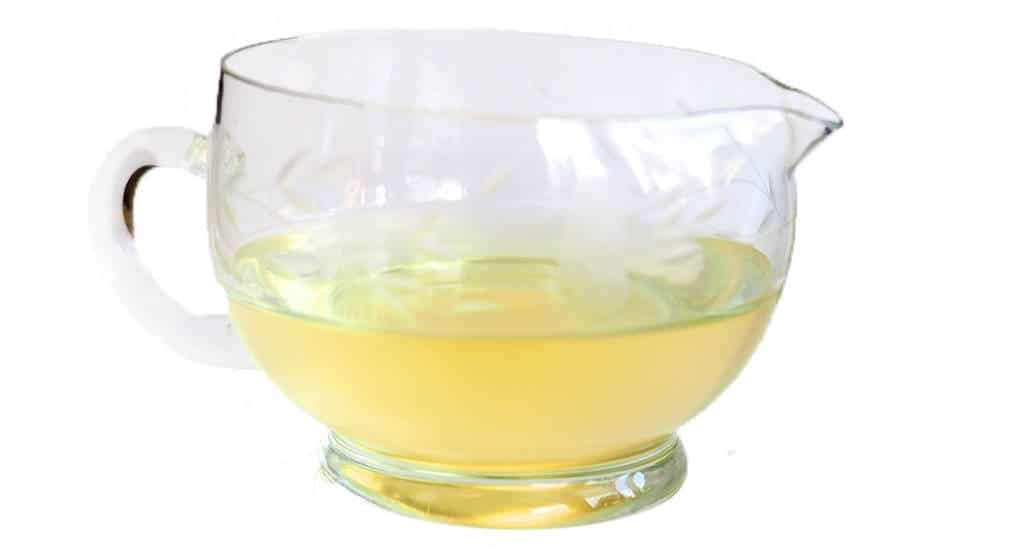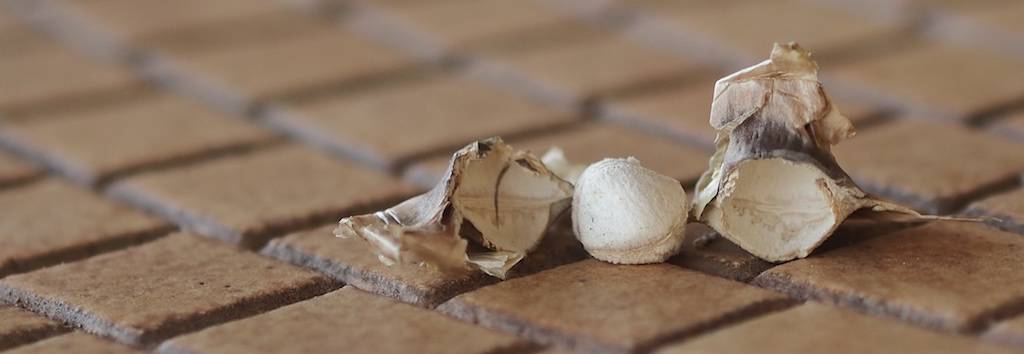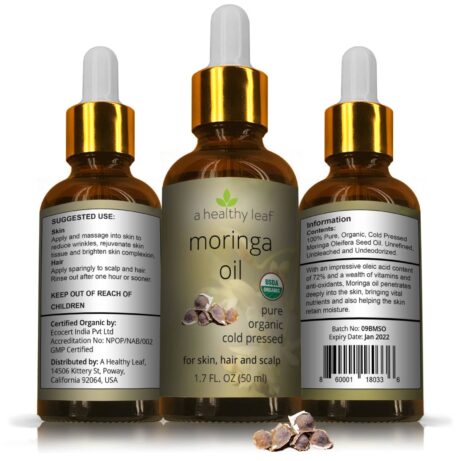Moringa Oil Benefits Overview | Where does Moringa oil come from? | Nutritional and Photochemical Properties of Moringa Oil | Moringa Oil Uses | Moringa Oil History | Moringa Oil Fatty Acid Composition Chart | Buy High Quality Moringa Oil
Most people living in the United states have limited knowledge of Moringa in general, much less Moringa oil and all the Moringa oil benefits! This page was written to give an overview of the amazing properties of this oil. We are excited to see what additional uses for this oil will be uncovered and documented as research continues! Moringa oil benefits are many and the list keeps growing as we learn more!

Moringa Oil Benefits Overview
Just as with Moringa leaves, Moringa oil benefits are many! The oil has many amazing properties not typically found in a single source. In addition to the oil’s high levels of oleic and behenic fatty acids, the oil has antioxidant and antihepatotoxicity properties. This makes the oil a powerful and natural tool for a wide range of applications and also makes the oil highly coveted in the cosmetic and health and beauty industries!
The oil is actually known commercially as ben oil, and it’s for good reason! This name was derived from the high quantity of behenic acid (up to 9%) that the oil contains. No other oil even comes close to having this level of behenic acid–but more on that later.
The oil has a pale yellow color, has a very mild nutty flavor, is odorless, is non-sticking, is non-drying, is liquid at room temperature and resists rancidity lasting for several years after it’s produced.
Where does Moringa oil come from?
Moringa oil comes from the seeds of the Moringa tree. Seeds have an outer hull protecting an inner seed kernel. The seed kernel, on average, contains 40% oil by weight. Oil is typically extracted by compressing the Moringa seeds in a screw press. Cold pressing the oil, which produces the highest quality product, also extracts the least amount of oil from the seeds. To extract more oil from the seeds, some manufacturers will heat the seeds and press or even use solvents. This practice increases the amount of oil obtained by nearly 50% but at the expense of the quality and purity level of the final product. Always be sure to look for cold pressed Moringa oil.

Approximately 500 Moringa seeds are required to produce 1 oz (29.6 mL) of cold pressed oil. This means it takes approximately 35 mature seed pods to produce 1 oz of oil! Now you know why cold pressed Moringa oil can cost as much as $10/oz for small quantities!
With vegetable oil costing about $0.05/oz, there is motivation for some less than moral individuals to dilute Moringa oil with cheaper oils, sell at a discounted rate, and still make tremendous profits. Please be sure to ask questions and know your source before buying.
Nutritional and Photochemical Properties of Moringa Oil
-
Moringa Oil Fatty Acids
Moringa oleifera seed oil, like olive oil, contains high amounts of monounsaturated acids. The oil is made of up to 72% oleic acid (C18:1) which is a monounsaturated, omega-9 fatty acid.[1] This high concentration of oleic acid gives the oil excellent moisturizing characteristics.
Of major significance is the fact that the oil also contains up to 9% behenic acid (C22:0). Behenic acid, a saturated fatty acid, is often used in moisturizers, hair conditioners and lubricating oils. It is the behenic acid’s conditioning properties that help to keep skin and hair soft and smooth. For comparison, peanut oil has the next highest concentration of behenic acid with up to 3%. Other oils contain very low levels (1% or less) of behenic acid if they contain it at all.[2]
For a complete list of fatty acids that make up Moringa oleifera oil, see the chart at the bottom of this page.
-
Vitamin E
Moringa seed oil is a good source of vitamin E found in three different tocopherols (α-, γ- and δ-). The tocopherol concentrations are reported to be 98.82–134.42, 27.90–93.70, and 48.00– 71.16 mg/kg, respectively.[3,4]
-
Sterols
Moringa oleifera oil contains small amounts of many phytosterols and even cholesterol as well. It is reported that the sterol composition of Moringa seed oil differs greatly from those of most of the conventional edible oils. [5]. Many of the Moringa oil benefits come from these sterols.
The sterols that are found in the highest concentration are listed below:
Moringa Oil Uses
Moringa oleifera oil is a light oil that is non-sticky and absorbs quickly into the skin.
- Moisturizer: With the oil’s high oleic acid content, it makes for an excellent, non-sticky, skin moisturizer. It can also be used on skin conditions such as psoriasis or eczema and chapped lips.
- Skin and Hair Care: Again because of the very high behenic acid concentration, the oil exhibits conditioning properties that help to keep skin and hair soft and smooth. The oil is very thin and spreads further than would be expected. Simply rub into skin or wash into wet hair.
- Cleanser: Oil is reported to help eliminate acne and blackheads. It may also help remove spots from acne when used on a long-term basis.
- Anti-aging oil: Due to the high anti-oxidant and behenic oil concentrations, the oil helps improve and rejuvenate the appearance of aging skin.
- Carrier oil for homemade massage oils: With the properties described above, the oil makes for a great carrier oil in homemade massage oils.
- Base for homemade perfume: Since the oil resists rancidity and has such a high oleic acid level, it makes an ideal choice for a perfume base. It also has the ability to absorb and retain scents and fragrances!
- Enfleurage Oil: Enfluerage is a traditional method of extracting essential oils and perfumes from flowers with an odorless plant or animal fats.
- Base for homemade soaps: The oil has been reported to make a good base for homemade soaps.
Moringa Oil History
There are many reports on the internet of Moringa oleifera oil being used in ancient Eqypt, Greece, Rome, etc. Although the oil has certainly been used for centuries, I would be leery of some claims that can’t state any references. An example of such a claim follows:
A tomb in Egypt was found to contain 10 jars of ‘Sweet Moringa oil’ thought to have been used in the funeral procession of Maya.”
Dr. Mark Olson, plant biologist and word renowned Moringa authority, gives us some insight to the history of Moringa oil. He states Moringa oleifera oil was likely not used in ancient Egypt. The oil was rather from another species of Moringa tree known as Moringa peregrina.
Purveyors of moringa will tell you all sorts of stories to get you to buy their products. Many of them try to get you to buy their Moringa pills by spinning stories of the Romans and the Egyptians anointing themselves with Moringa oil or energizing themselves with dried Moringa leaves, not unlike the very pills they are selling.
As often the case, these vendors haven’t quite gotten the story right. The folks selling Moringa pills and other products are selling Moringa oleifera from India and Pakistan. The Romans and Egyptians used oil from Moringa peregrina, which is found from the Dead Sea area south on both sides of the Red Sea, around the southern Arabian Peninsula as well as in northern Somalia (but not, oddly, on Socotra).[16]
Having said that, Dr. Olsen goes on to say:
There is abundant archaeological evidence of the use of M. peregrina in Egypt and around the ancient Mediterranean.
According to Theophrastus, oils were used as bases that could receive and retain the scents. [Moringa peregrina oil], extracted from nuts growing on bushes in the Syrian and Egyptian deserts, was the most valuable, being the least viscous and the most receptive [to absorbing perfume scents].
Clapham and Rowley-Conwy (2007) give an interesting record of the presence of M. peregrina samples at Qasr Ibrim, once a major city in what is now Lake Nasser, Egypt. They show that traces of M. peregrina fruits are present over a period comprising as early as the 7th century BC to as late as 650 AD, a stunningly long period of documented use.[16]
In much more recent history, records do actually exist of Moringa oleifera oil. Dr. Sutherland, Moringa researcher from the University of Leicester states the following:
In 1817 a petition containing particulars relating to the oil from M.oleifera was presented to the Jamaican House of Assembly. The petition described the oil as being useful for salads and culinary purposes and to be equal to the best Florence oil as an illuminant giving a clear light without smoke. A subsequent paper presented to the Jamaica Society of Arts in 1854 described how samples of oil had been tested by two watch making establishments in Kingston and had been reported to be equal to the expensively imported ‘watch oil’. Subsequent reports indicated that the oil was used extensively as a lubricant until being replaced by sperm-whale oil.[17]
Today there is a global market for Moringa oleifera oil. Unique properties and benefits of the oil have also made it increasingly popular as a base for many cosmetic products.
Moringa Oil Fatty Acid Composition
Data presented in the table below was taken from research conducted on the seed oil from the “Periyakulam 1” Moringa oleifera seed in 2000.[1]
[table id=6 /]
Buy High Quality Moringa Oil
-
Moringa Products
Moringa Oil: Certified Organic Moringa Seed Oil
$18.95 – $29.95 Select options This product has multiple variants. The options may be chosen on the product page
For Moringa Information About Moringa Benefits see our Moringa Benefits Page
References
[1] Lalas, Stavros, and John Tsaknis. “Characterization of Moringa oleifera seed oil variety “Periyakulam 1”.” Journal of Food Composition and Analysis 15.1 (2002): 65-77.
[2] Zambiazi, Rui C., et al. “Fatty acid composition of vegetable oils and fats.” B. CEPPA, Curitiba 25.1 (2007): 111-120.
[3] Anwar, Farooq, and M. I. Bhanger. “Analytical characterization of Moringa oleifera seed oil grown in temperate regions of Pakistan.” Journal of Agricultural and Food Chemistry 51.22 (2003): 6558-6563.
[4] Tsaknis, J., et al. “Characterization of Moringa oleifera variety Mbololo seed oil of Kenya.” Journal of Agricultural and food chemistry 47.11 (1999): 4495-4499.
[5] Rossell, J. B., and J. L. R. Pritchard. Analysis of oilseeds, fats and fatty foods. Elsevier Science Publishers Ltd., 1991.
[6] BETA-SITOSTEROL: Uses, Side Effects, Interactions and Warnings – WebMD. (n.d.). Retrieved January 19, 2016, from http://www.webmd.com/vitamins-supplements/ingredientmono-939-beta-sitosterol.aspx?activeingredientid=939&activeingredientname=beta-sitosterol
[7] Panda, S., et al. “Thyroid inhibitory, antiperoxidative and hypoglycemic effects of stigmasterol isolated from Butea monosperma.” Fitoterapia 80.2 (2009): 123-126.
[8] Gabay, Odile, et al. “Stigmasterol: a phytosterol with potential anti-osteoarthritic properties.” Osteoarthritis and Cartilage 18.1 (2010): 106-116.
[9] Ogbunugafor, H. A., et al. “Physico-chemical and antioxidant properties of Moringa oleifera seed oil.” Pakistan Journal of Nutrition 10.5 (2011): 409-414.
[10] Lalas, Stavros, et al. “Determination of antimicrobial activity and resistance to oxidation of Moringa peregrina seed oil.” Molecules 17.3 (2012): 2330-2334.
[11] Olatosin, T. M., D. S. Akinduko, and C. Z. Uche. “Evaluation of the Hepatoprotective Efficacy of Moringa oleifera Seed Oil on Ccl4-Induced Liver Damage in Wistar Albino Rats.” The International Journal of Engineering and Science (IJES) 2.11 (2013): 13-18.
[12] Chuang, Ping-Hsien, et al. “Anti-fungal activity of crude extracts and essential oil of Moringa oleifera Lam.” Bioresource Technology 98.1 (2007): 232-236.
[13] CSIR, 1962 The Wealth of India, A Dictionary of Indian Raw Materials and Industrial Products. Raw Materials, Vol. VI. Publications and Information Directorate, Council of Scientific & Industrial Res., New Delhi.
[14] ARROTTA, J. A., 2001: Healing Plants of Peninsular India, CABI Publishing, Wallingford, UK and New York, NY, USA
[15] The Uses of Moringa Tree. (2015, October 27). Retrieved January 19, 2016, from http://www.livestrong.com/article/129663-uses-moringa-tree/
[16] Romans and Egyptians using Moringa? (n.d.). Retrieved January 19, 2016, from http://moringaceae.org/1/post/2013/09/romans-and-egyptians-using-moringa.html
[17] M.oleifera oil. (n.d.). Retrieved January 19, 2016, from http://www.le.ac.uk/engineering/staff/Sutherland/moringa/oil/oil.htm
Other references:
Rahman, Ismail MM, et al. “PHYSICOCHEMICAL PROPERTIES OF MORINGA OLEIFERA LAM. SEED OIL OF THE INDIGENOUS‐CULTIVAR OF BANGLADESH.” Journal of Food Lipids 16.4 (2009): 540-553.
Anwar, Farooq, Syeda Nahid Zafar, and Umer Rashid. “Characterization of Moringa oleifera seed oil from drought and irrigated regions of Punjab, Pakistan.” Grasas Y Aceites 57.2 (2006): 160-168.
Tsaknis, J., et al. “A total characterisation of Moringa oleifera Malawi seed oil.” Rivista Italiana delle Sostanze Grasse 75 (1998): 21-28.

